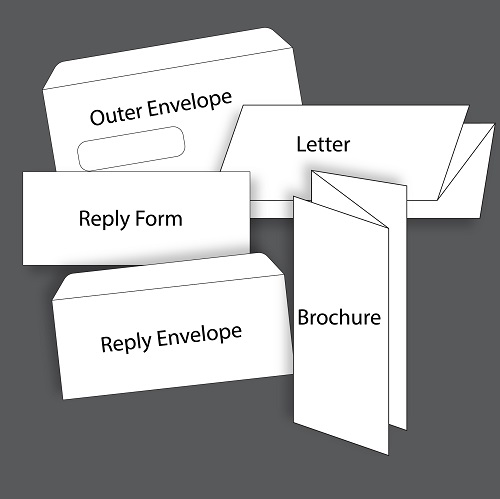29 Jan The Advantages of the Traditional Direct Mail Package

The traditional direct mail package usually consists of an outer envelope with a personalized letter, reply form, a brochure or flyer and a reply envelope.
The Advantages of the Traditional Direct Mail Package
Whenever a client asks us to recommend a format for their direct mail effort, we always say that, budget permitting, the best choice is what is known in the direct marketing industry as the “traditional direct mail package”.
This classic format has ruled direct mail for well over one hundred years, proving again and again that it has the power to pull more response than pretty much any other format choice.
Of course, there are many other factors that affect response, so even this tried and true choice is not always an ironclad guarantee of success. But there’s no question that, in the hands of experienced and knowledgeable direct marketers, the classic direct mail package is a very powerful weapon indeed.
What the Traditional Direct Mail Package Looks Like
The traditional direct mail package comes in a variety of flavours, but in general will consist of the following elements:
The Outer Envelope: They come in all sizes. Sometimes with a window, or even more than one window. Sometimes it is close-faced. It can be discreet, with only a return address, or it can be a full colour extravaganza that loudly demands your attention.
In Canada, the most commonly used and most economical envelope sizes are #10 (4 1/8” high x 9 1.2” long), the 6”x9” variant (which was originally this size, but these days always seems to be 5 ¾” high x 9 ½” long) and the large 9” x 12” size.
There are many other sizes to choose from, some of which are custom sizes. There are also other options that are not quite what we think of as envelopes, such glassine envelopes and poly bags.
The Reply Form: Sometimes called the response device, other times the order form, this is usually what we want the recipient of the package to “do” — that is, we want them to complete and return the form. In the age of web-driven response, many packages lack a response device, leaving it to the other elements in the package to drive action. We often wonder if this is a mistake. It certainly is worth testing.
The Letter: Ah, the letter. We will write more, much more, about this indispensable iconic tool of the direct mail craft in future posts. Besides the reply form, the letter is considered the most important element of the traditional direct mail package.
It is usually personalized (though not always — remember “Dear friend”?) and can be as short as a single page or consist of many pages. Most typically, it will be two pages long, though many mail order letters are 4 pages long. (Length is one the factors that can and should be tested.)
In many packages, the letter and reply form are combined into one format, often with a perforation so that the reply form can be easily removed. This is especially so when there is a desire for both pieces to be personalized.
The letter is used to present the recipient with the proposition, provide information that attempts to overcome possible objections and persuade them to act. The best letters are written as though from one person to another.
The Brochure: This piece is not always a true brochure. It is sometimes a flyer, a pamphlet or even a buckslip. It is typically thought of as the piece that adds visual flair and colour to the package, showing a product in all its glory and enhancing the recipient’s understanding of its features and benefits.
The Reply Envelope: The pre-addressed reply envelope makes it easier for recipients to respond to your proposition. Even better is the Business Reply Envelope (BRE) or postage-paid reply envelope.
The power of the traditional direct mail format is such that it has often been adapted for use for unaddressed mailings (Neighbourhood Mail), not just addressed mail (Personalized Mail). In a mailbox or Super Mailbox stuffed full of flyers and postcards, it’s a format that stands out and conveys and inherent promise of seriousness and value.
There is no question that the traditional direct mail package costs more to produce than formats such as postcards and self-mailers. But it remains the most response-inducing format available to mailers, even in the age of digital marketing.
Perhaps that is because it continues to be emblematic of the most inherently appealing strengths of the medium: it is personal, it says “open me and you may be surprised”, and when done well, is creative and compelling.


